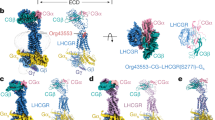Abstract
Steroid receptors exist in cytosol as 9S, non-DNA-binding species and as 4S (transformed) species that bind to DNA or nuclei. Labeling the progesterone receptor from rabbit uterine cytosol with [3H]progesterone in the presence of 10 mM sodium molybdate revealed a 9S species on sucrose gradient centrifugation. Without molybdate, the receptor sedimented as an intermediate species of 6S, which converted to 4S in 0.3 M NaCl. The 6S species could also be generated from the 4S species by dialysis. Dilution of the same 4S species gave only partial re-aggregation with 50% of the receptor remaining as 4S. Dialysis appeared to retain the association of a macromolecular aggregation factor present in cytosol. Serum did not seem to be the source of the aggregation factor, as perfusion of the uterine vasculature before excision did not affect the S value of the receptor. We tested whether RNA was involved by treating receptor with RNase A (100 µg/400 µl cytosol). While the molybdate-stabilized cytosol receptor (9S) was unaffected, RNase A partially (50%) converted the 6S form of receptor to 4S. RNase A also partially converted the re-aggregated form back to 4S. Protease inhibitors had no effect on this action of RNase. Formation of receptor-ribonucleotide protein particles may play a role in steroid action in the cell.
Similar content being viewed by others
References
Sherman MR, Moran MC, Tuazon FB, Stevens Y-W: J Biol Chem 258:10366–10377, 1983.
Murayama A, Fukai F, Yamamoto T: J Biochem (Tokyo) 88:1457–1466, 1980.
Jensen EV, Numata M, Brecher PI, DeSombre ER: Biochem Soc Symp 32:133–159, 1971.
Colvard DS, Wilson EM: Endocrinology 109:496–504, 1981.
Rowley DR, Premont RT, Johnson MP, Young CYF, Tindall DJ: Endocrinology 116A:667, 1985.
Seeley DH, Costas PD: Mol Cell Endocrinol 30:161–178, 1983.
Schrader WT, Heuer SS, O'Malley BW: Biol Reprod 12:134- 142, 1975.
Vedeckis WV: Biochemistry 22:1975–1983
Vedeckis WV: Biochemistry 22:1983–1989, 1983.
Renoir, J-M, Mester J: Mol Cell Endocrinol 37:1–13, 1984.
Eastman-Reks SB, Reker CE, Vedeckis WV: Arch Biochem Biophy 230:274–284, 1984.
Reker CE, Kovacic-Milivogevic B, Eastman-Reks SB, Vedeckis WV: Biochemistry 24:196–204, 1985.
Lamb DJ, Bullock DW: Endocrinology 114:1833–1840, 1984.
Liao S, Liang T, Tymoczko JL: Nature New Biol 241:211–213, 1973.
Liang T, Liao S: J Biol Chem 249:4671–4678, 1974.
Lin S-Y, Ohno S: Biochim Biophys Acta 654:181–186, 1981.
Lin S-Y, Ohno S: Eur J Biochem 124:283–287, 1982.
Thomas T, King DT: J Steroid Biochem 23:19–25, 1985.
Rossini, GP: J Steroid Biochem 22:47–56, 1985.
Tymoczko JC, Phillips MM: Endocrinology 112:142–148, 1983.
Lamb DJ, Bullock DW: J Steroid Biochem 19:1039–1045, 1982.
Franceschi RT, DeLuca HF: J Biol Chem 254:11629–11635, 1979.
Franceschi RT, DeLuca HF, Mercado DL: Arch Biochem Biophys 222:504–517, 1983.
Tymoczko JC, Phillips MM, Vernon SM: Arch Biochem Biophys 230:345–354, 1984.
Hutchens TW, Markland FC, Hawkins EF: Biochem Biophys Res Commun 105:20–27, 1982.
Chong MT, Lippman ME: J Biol Chem 257:2996–3002, 1982.
Tymoczko JL, Lee JH: Biochim Biophys Acta 846:193–199, 1985.
Mulder E, Vrig AA, Brinkman AO, van der Molen HJ, Parker MG: Biochim Biophys Acta 781:121–129, 1984.
Kovacic-Milivojevic B, LaPointe MC, Reker CE, Vedeckis WV: Biochemistry 24:7357–7366, 1985.
Firgaira FA, Hendrick JP, Kalousek F, Krans JP, Rosenberg LE: Science 226:1319–1322, 1985.
King WT, Greene GL: Nature 307:745–747, 1984.
Welshons WV, Lieberman ME, Gorski J: Nature 307:747–749, 1984.
Theofan G, Notides AC: Endocrinology 114:1173–1179, 1984.
McKnight GS, Palmiter RD: J Biol Chem 254:9050–9058, 1979.
Author information
Authors and Affiliations
Rights and permissions
About this article
Cite this article
Lamb, D.J., Kima, P.E. & Bullock, D.W. Occurrence of a 6S intermediate form of the progesterone receptor that is sensitive to ribonuclease. Mol Cell Biochem 73, 77–84 (1987). https://doi.org/10.1007/BF00229379
Received:
Issue Date:
DOI: https://doi.org/10.1007/BF00229379




